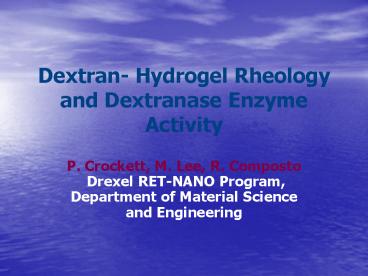Dextran Hydrogel Rheology and Dextranase Enzyme Activity - PowerPoint PPT Presentation
1 / 15
Title:
Dextran Hydrogel Rheology and Dextranase Enzyme Activity
Description:
Hydrogels are used for a wide array of biomaterials applications, such as: ... of Hydrogels include: Hydrophilicity, elasticity, and can be modulated chemically. ... – PowerPoint PPT presentation
Number of Views:372
Avg rating:3.0/5.0
Title: Dextran Hydrogel Rheology and Dextranase Enzyme Activity
1
Dextran- Hydrogel Rheology and Dextranase Enzyme
Activity
- P. Crockett, M. Lee, R. Composto Drexel
RET-NANO Program, Department of Material Science
and Engineering
2
Introduction
- Hydrogels are used for a wide array of
biomaterials applications, such as contact
lenses, drug delivery vehicles, and tissue
adhesives. - The favorable properties of Hydrogels include
Hydrophilicity, elasticity, and can be modulated
chemically. - Dextrans are carbohydrate polymers with
properties that mimic biological sugars found on
tissue surfaces. - Dextran coated surfaces can be used to grow up
cells to later be cleaved as a sheet via
Dextranase..
3
Materials and Methods
- The first part of our research focused on how
Dextran-GMA Hydrogel compliance varies with
concentration. - The second part of our research was focused on
the effect of Dextranase on our Dextran. - Once the optimal pH and temperature are found, we
hope to compare and contrast Dextranase activity
with Dextran and Dextran-GMA Hydrogel.
4
(No Transcript)
5
(No Transcript)
6
(No Transcript)
7
(No Transcript)
8
(No Transcript)
9
Conclusions
- Dextran-GMA Hydrogels were analyzed at various
concentrations using rheometry. Hydrogel
compliance increased linearly with concentration. - A color change assay was produced using optimal
Maltose concentrations. - Enzyme activity was found to degrade 2 Dextran
at close to suppliers specifications. - Dextranase was found to have negligible activity
difference at pH 6 and pH 7. - Enzyme activity proved to be significantly
enhanced by activator at pH 6 but lost it
effectiveness at pH 7.
10
(No Transcript)
11
(No Transcript)
12
(No Transcript)
13
(No Transcript)
14
References
- 1. Influence of the degradation mechanism of
Hydrogels on their elastic and swelling
properties during degradation - Meyvis, T.K.L. (Ghent Univ) De Smedt, S.C.
Demeester, J. Hennink, W.E. Source
Macromolecules, v 33, n 13, Jun, 2000, p
4717-4725 - 2.Swelling pressure of Hydrogels that degrade
through different mechanisms - Stubbe, B.G. (Lab. Gen. Biochem. and Phys.
Pharm., Department of Pharmaceutics, Ghent
University) Hennink, W.E. De Smedt, S.C.
Demeester, J. Source Macromolecules, v 37, n
23, Nov 16, 2004, p 8739-8744 - 3.Enzymatic degradation of cross-linked Dextrans
- Franssen, O. (Universiteit Utrecht) van Ooijen,
R.D. de Boer, D. Maes, R.A.A. Hennink, W.E.
Source Macromolecules, v 32, n 9, May, 1999, p
2896-2902
15
Acknowledgments
- I would like to thank Dr. Composto and Dr.
Boettiger for allowing me the opportunity to
utilize their laboratory resources. Dr. Mark Lee
for being an excellent teacher and providing me
with an exciting project to work on. Drexel
RET-NANO for allowing this teacher to the
opportunity to bring cutting edge research back
to my students.































